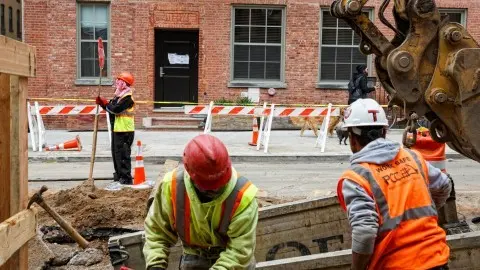US jobs: A likely story…
A surge in payrolls, workers coming back to the jobs market and companies not having to pay staff more is the message from the February jobs report. We have our doubts about this…
Too good to be true?
The US jobs report for February shows payrolls rose 313,000 last month (with 54,000 upward revisions), versus the consensus forecast of 205,000 reinforcing the message that a 25bp Federal Reserve interest rate hike on 21 March is a done deal. Despite this, the unemployment rate remained at 4.1%, rather than dropping to 4% as expected while wage growth rose only 0.1% month-on-month, meaning the annual rate of wage growth slipped to 2.6% from a downwardly revised 2.8%.
The working week also increased to 34.5 hours from an upwardly revised 34.4 and the labour participation rate jumped from 62.7% to 63%. Essentially the data says around 800k people suddenly entered the jobs market last month and virtually all found work (unemployment only increased 22k).
On the face of it, this is a fantastic story. Rising wage growth and the prospect of “better” jobs has led people to return to the workforce and companies are able to fill their vacancies without increasing pay i.e. non-inflationary growth. Except that this isn’t the story we are getting from other reports.

Other reports tell a different story...
Yesterday’s National Federation of Independent Business labour survey showed small businesses are increasingly struggling to find workers with a net 22% saying this is the greatest impediment to doing business (the largest single factor cited). As such, the competition to find new - and retain current - staff meant that the proportion of businesses raising pay was its largest since 2000 and the net proportion planning to raise pay is close to 19-year highs.
With JOLTS data showing that there is only one unemployed worker for every new job opening, it is also clearly a problem for larger corporations. As such, it is taking longer to fill vacancies. Consequently, we are a little sceptical of today’s jobs report and instead we think payrolls growth will slow and wage growth will quicken in coming months.
This is just one reason why we think headline consumer price inflation could hit 3% in the summer (others include dollar weakness, rising commodity prices, cell phone data plan quirks and medical care costs). As such, we look for four rate hikes this year, starting in March, with the Fed signalling a clear willingness to do so in updated forecasts
This publication has been prepared by ING solely for information purposes irrespective of a particular user's means, financial situation or investment objectives. The information does not constitute investment recommendation, and nor is it investment, legal or tax advice or an offer or solicitation to purchase or sell any financial instrument. Read more
Download
Download snap
9 March 2018
Week in Review: Economics trumps politics This bundle contains 5 Articles